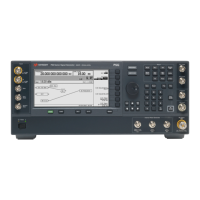Keysight Signal Generators Programming Guide 55
Using IO Interfaces
Using LAN
4. Monitor Response as on page 53.
This may be done assuming that the Output LAN event had been configured from the front panel
(page 52) or SCPI commands (page 53).
Using the LXI Event Log
The LXI subsystem also provides an Event Log. The event log records all of the enabled LXI Event
and Instrument Event activity and associates each action with an IEEE 1588 timestamp. Instrument
Events are enabled by default, and will therefore appear in the log. Since many instrument events
occur during every sweep, logging all of them may flood the event log. They may be disabled by
sending the SCPI command:
:LXI:EVENt:STATus:ENABled “instrumentEvent”,0
where the parameter “instrumentEvent” may be any event listed in Table 2-1. Note that the event
must be re–enabled before being used as the source of an LXI Output LAN Event.
To view the LXI Event Log from the front panel, press the hard key System and then the softkeys
Show, LXI, LXI Event Log. Once the Event Log is displayed, the arrow keys may be used to scroll
through the list. The Event Log may also be queried through SCPI command.
Setting up and executing a list sweep measurement
The following examples will illustrate procedures for setting up and executing a list sweep
measurement using an MXA and an MXG synchronized with LXI.
Before launching into the procedure, it is important to understand the theory behind the method.
The MXA and MXG use their LXI Output LAN Events to communicate internal state changes to each
other. In the following synchronization, the rising edge of the Waiting For Trigger instrument event
will be used to communicate to the other device that the next step may be executed.
For clarity, the MXG's Waiting For Trigger instrument event is mapped to the LAN0 output event.
Likewise, the MXA's Waiting For Trigger instrument event is mapped to the LAN1 output event.
The MXA is configured to trigger when it receives the LAN0 event with a rising edge. The MXG is
configured to trigger when it receives the LAN1 event with a rising edge. Also, the
OperationComplete output event is enabled, which has the OperationComplete instrument event
mapped to it by default.
The MXG's list sweep is started first, causing it to source the first signal in its list. We then start the
MXA's list sweep. The OperationComplete instrument event transitions low, causing an
OperationComplete output event to go out on the LAN with a falling edge. The MXA takes a
measurement at the first frequency in its list. When the MXA has finished its measurement, it moves
on to the next entry in its list. The Waiting For Trigger instrument event transitions high, causing
a LAN1 output event to go out onto the LAN with a rising edge, and the MXA waits for its next
trigger.
The MXG receives the LAN1 event and triggers. The MXG's Waiting For Trigger instrument event
transitions low, and a LAN0 output event goes onto the LAN with a falling edge. The MXA takes no
action, since it is configured to trigger only on rising edges. The MXG is now sourcing the next signal
in its list. Once that signal has settled, it prepares to move on to its list's next entry. The MXG's
Waiting For Trigger instrument event transitions high, and a LAN0 output event goes onto the LAN
with a rising edge. The MXG waits for its next trigger.

